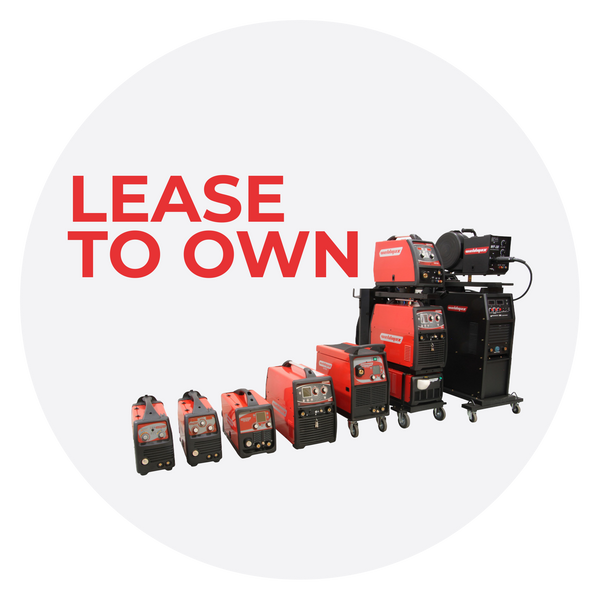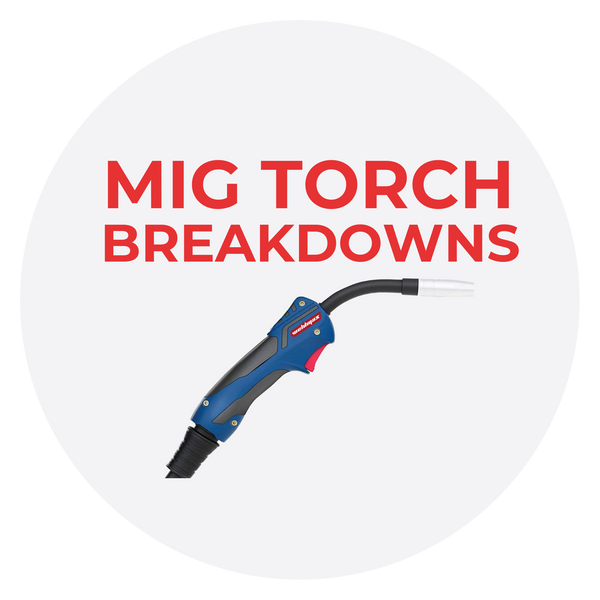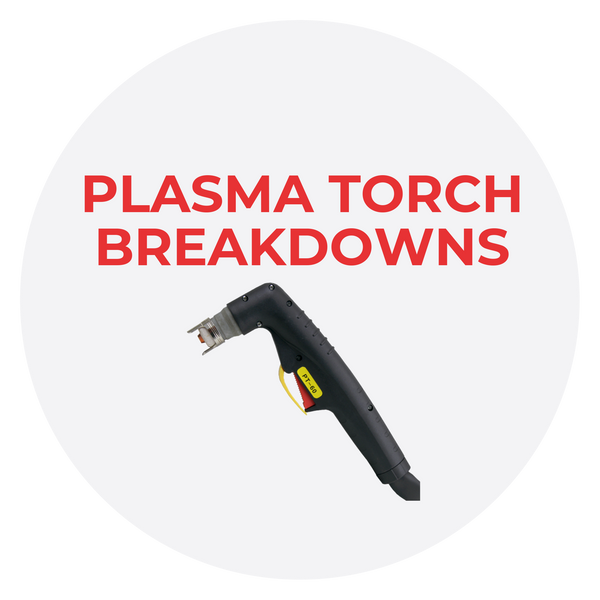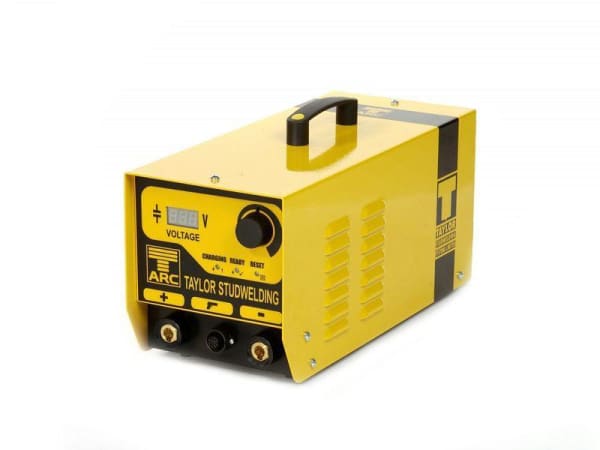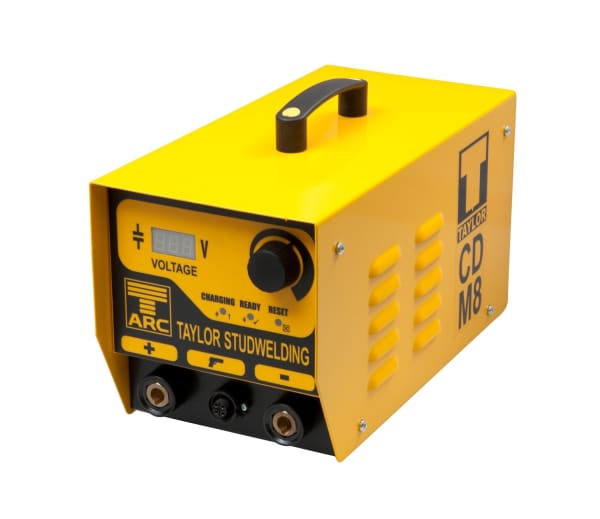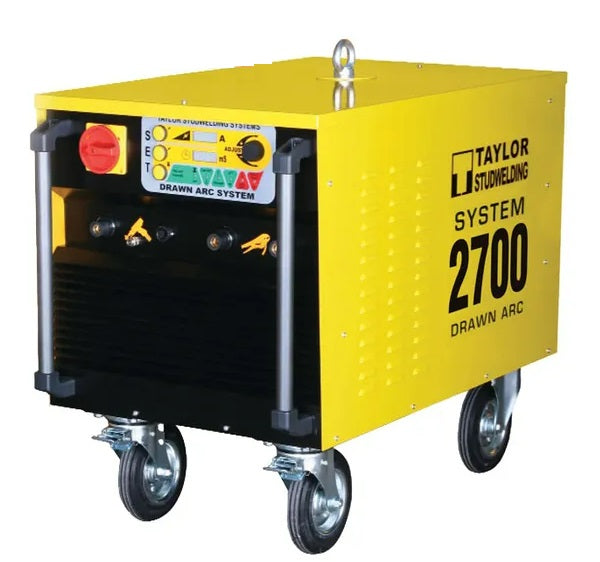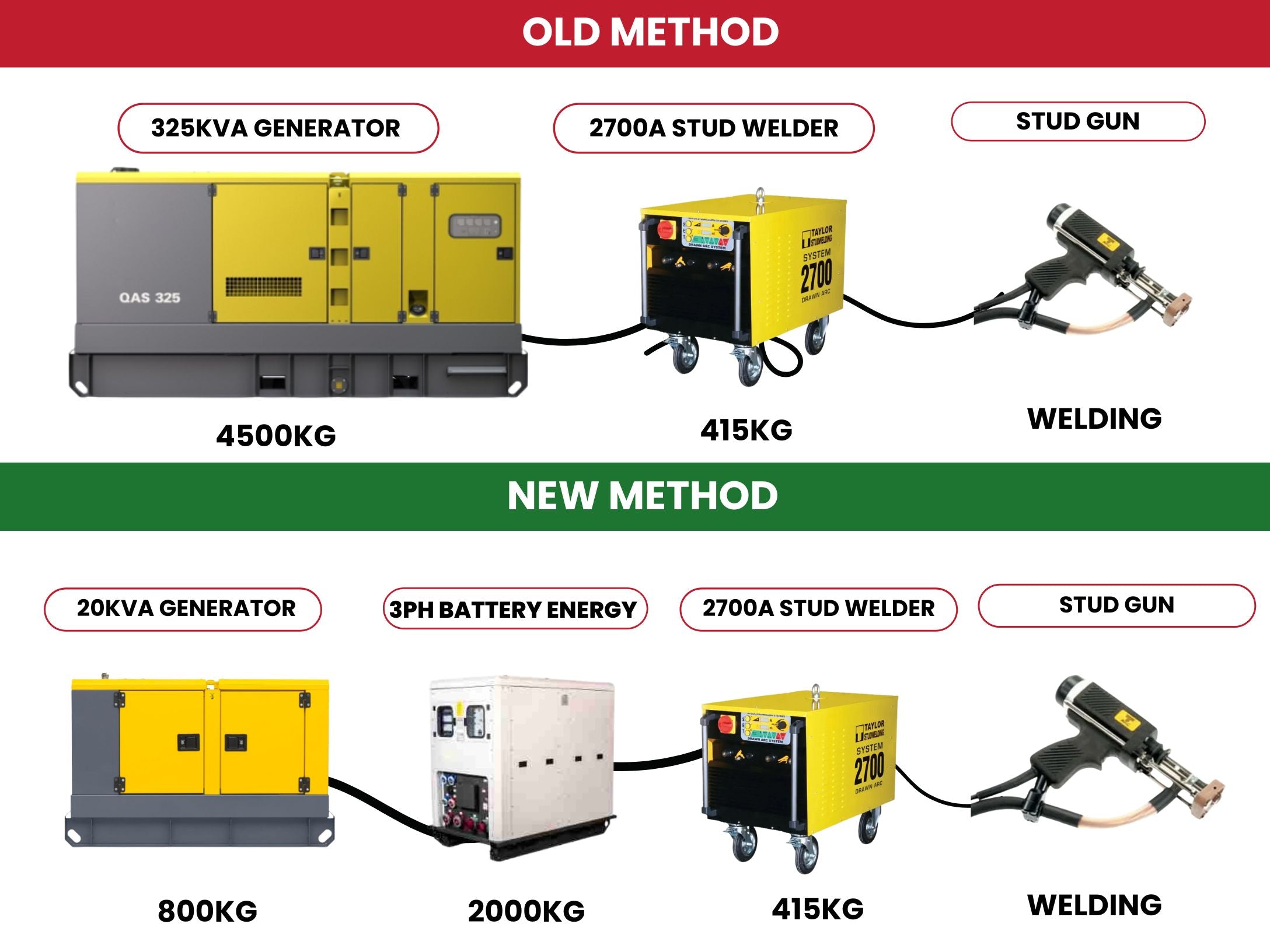SITE STUD WELDING MADE EASY WITH GENERATORS
Break-through battery technology revolutionizes stud welding on construction sites using diesel generators

Stud welding has long been an essential process in the construction industry, offering a fast and reliable method for attaching metal fasteners to steel structures.
Traditionally, the process relied on bulky and power-hungry equipment that often required extensive cabling and a stable electrical supply. However, recent advancements in battery technology are revolutionizing stud welding, making it more efficient and accessible on construction sites—especially when used with diesel generators.
This breakthrough technology is setting a new standard for mobility, performance, and ease of use, ensuring that site stud welding becomes more streamlined than ever before.
Stud welding of shear studs and threaded studs on construction sites, remote locations and site power has been fraught with issues for many years due to the slow excitation of heavy duty generators.
With break-through technology used in battery energy storage systems, this enables instant delivery of the required in-rush current at the correct voltage during the short welding process known as stud welding.
Stud welders need instant delivery of 415 volt power supply at high current (circa 125amps) to make the weld process successful, and even more critical when welding "out of position" (vertical or overhead).
The Challenges of Traditional Stud Welding

Power Constraints – Conventional stud welders require a high and stable power supply, making them dependent on large and often unreliable site generators or direct electrical hookups.
Cumbersome Equipment – Traditional stud welding setups include heavy transformers, lengthy cables, and high-maintenance power sources, leading to logistical difficulties on job sites.
Limited Mobility – With traditional equipment, workers often find themselves restricted in their movement due to power cable limitations, which can be hazardous and inefficient.
Downtime and Delays – Power fluctuations, voltage drops, and equipment malfunctions can cause frequent interruptions, reducing productivity and increasing project timelines.
Breakthrough Battery Technology: The Future of Site Stud Welding
Innovations in battery technology are now transforming site stud welding by allowing the integration of portable, high-performance battery-powered systems that work seamlessly with diesel generators. Here's how:
1. High-Powered Battery Integration
New-generation stud welders come equipped with high-capacity lithium-ion batteries that provide a stable and robust power source. These batteries significantly reduce reliance on direct grid power and make it possible to operate efficiently using compact diesel generators.
2. Seamless Compatibility with Diesel Generators
By combining battery-assisted stud welding units with diesel generators, construction crews can enjoy continuous operation without voltage drops. The battery buffers power demand spikes, preventing overloading and ensuring consistent performance.
3. Portability and Reduced Setup Time
Battery-powered stud welders are lightweight and easily transportable. Without the need for excessive cabling, workers can set up their welding stations faster, improving overall site productivity.
4. Increased Efficiency and Productivity
With this new technology, welders can operate in remote areas without being restricted by generator placement. This means that welding can be done in multiple locations without constant repositioning of power sources, greatly enhancing workflow efficiency.
5. Cost Savings and Fuel Efficiency
Using battery-assisted welding reduces the strain on diesel generators, leading to lower fuel consumption and operational costs. This makes the entire welding process more cost-effective in the long run.

Applications in Construction
This breakthrough in stud welding is particularly beneficial in:
Bridge and highway construction – Enables fast and efficient stud attachment even in remote locations.
Steel frame buildings – Reduces power dependency while improving welding speed.
Shipbuilding and offshore structures – Enhances flexibility in environments where electrical power access is limited.
Railway infrastructure – Allows for seamless stud welding operations along tracks and tunnels.

20kVA + 3ph BESS vs. 325kVA Generator
Fuel Efficiency & Cost Savings
Using a three-phase (3ph) battery energy storage system (BESS) with a 20 kVA diesel generator instead of relying solely on a 325 kVA diesel generator for stud welding has several advantages:
✅ Peak Load Management: Stud welding has high instantaneous power demands, but the overall duty cycle is low. A BESS can handle peak loads, allowing the smaller 20 kVA generator to operate efficiently at its optimal load.
✅ Reduced Fuel Consumption: A 325 kVA generator running at low load is inefficient, leading to high fuel consumption. The 20 kVA generator with a BESS buffer runs closer to its optimal efficiency.
✅ Lower Maintenance Costs: Running a large diesel generator at low loads causes wet stacking, carbon buildup, and inefficient fuel combustion, leading to higher maintenance costs. stud welding tasks.
Improved Power Quality
✅ Stable Voltage & Frequency: Stud welding creates sharp power spikes that can cause voltage dips and frequency instability in a diesel generator-only system. A BESS smooths power delivery, preventing fluctuations that could affect welding quality.
✅ Reduced Transients & Harmonics: Diesel generators alone may struggle with the transient loads of welding. A BESS absorbs these fluctuations, reducing wear and tear on electrical components.
Lower Noise & Environmental Impact
✅ Reduced Generator Runtime: The BESS can supply power during low-load periods, allowing the diesel generator to shut down or run intermittently, reducing noise and emissions.
✅ Lower Carbon Footprint: Fuel savings directly translate into lower CO₂ emissions, which is beneficial for environmental compliance and sustainability goals.
Scalability & Redundancy
✅Expandable Storage: The BESS capacity can be increased as needed, whereas a single large generator has a fixed output.
✅ Redundant Power Supply: If the 20 kVA generator fails, the BESS can supply power temporarily, allowing for controlled shutdowns or transition to backup power.
Reduced Generator Sizing & CAPEX
✅Avoids Oversized Generator Costs: A 325 kVA diesel generator is oversized for typical stud welding loads, leading to unnecessary capital expenditure. A BESS with a smaller generator is a cost-effective alternative.
✅ Longer Equipment Lifespan: The large generator may experience shorter life expectancy due to cycling and inefficient operation. The BESS reduces generator runtime and stress, extending its lifespan.
Using a three-phase battery storage system with a 20 kVA diesel generator instead of a 325 kVA diesel generator offers significant fuel efficiency, cost savings, power quality improvements, environmental benefits, and equipment longevity. This hybrid approach optimizes energy usage and ensures stable power for stud welding applications.
Why opt for a Battery Energy Storage System (BESS)?
Cost Savings and Energy Efficiency

Electricity prices fluctuate throughout the day, often spiking during peak demand hours.
BESS enables users to store electricity when prices are low and use it when rates increase, a process known as peak shaving. This reduces energy costs for both businesses and residential consumers while decreasing reliance on expensive grid electricity.
Environmental Benefits

The welding industry contributes to carbon emissions, especially when using diesel or gasoline-powered generators. Battery Energy Storage Systems help reduce the environmental impact of welding operations by:
- Lowering reliance on fossil fuels
- Decreasing greenhouse gas emissions
- Supporting the use of renewable energy sources
When combined with solar or wind power, BESS can create a more sustainable and eco-friendly welding process, aligning with global efforts toward carbon neutrality and green manufacturing.
Consistent and Reliable Power Supply

Fluctuations in power supply can affect welding quality, leading to inconsistent welds, defects, and potential safety hazards. BESS provides a stable power output, ensuring:
- Uniform arc performance
- Reduced voltage drops
- Improved weld penetration and bead quality
This reliability is crucial in industries where precision welding is required, such as aerospace and automotive manufacturing.
Noise Reduction and Workplace Safety
Fuel-powered generators used in welding are noisy and can create hazardous working conditions due to exhaust emissions and heat generation. BESS-powered welding systems are significantly quieter and produce no emissions, improving workplace safety and comfort. This is particularly important in indoor welding environments where ventilation is a concern.

Maintenance
Maintenance costs for BESS typically include the following:

Battery Inspections: Checking for degradation, thermal hotspots, and state of charge (SOC) balancing.
Cooling System Maintenance: Cleaning and servicing HVAC or liquid cooling systems.
Routine Maintenance (Annual or Bi-Annual)
Inverter Maintenance: Ensuring proper operation of inverters, transformers, and power electronics.
Software Updates: Firmware updates for Battery Management System (BMS) and control software.
Physical Inspections: Checking for corrosion, loose connections, and enclosure integrity.
Fire Suppression System Maintenance: Verifying fire suppression and safety mechanisms.
Battery Replacements: Lithium-ion (Li-ion) batteries degrade over time, requiring module replacements (usually after 7–15 years).
Component Failures: Addressing failures in power conversion systems (PCS), HVAC, sensors, or battery packs.
The service life of a Battery Energy Storage System (BESS) depends on various factors, including battery chemistry, usage patterns, depth of discharge (DoD), temperature conditions, and maintenance.
Corrective Maintenance (As Needed)

Operating Costs
Operating costs mainly include:

Energy Costs:
Charging Costs: If the BESS is charged from the grid, costs depend on electricity rates.
Efficiency Losses:
Li-ion BESS has round-trip efficiency of 85–95%, leading to energy losses that must be factored into costs.
Battery Degradation & Replacement:
Li-ion batteries degrade over time (typically 2–3% per year).
Replacement costs depend on battery chemistry and market prices.
Cooling & HVAC Costs:
Energy consumption of HVAC systems can add 2–5% to operating costs.
Higher temperatures accelerate degradation, increasing long-term costs.
Software & Communication Costs:
Remote monitoring & SCADA integration may have subscription costs.
Cybersecurity & firmware updates are required for secure operations.
Insurance & Compliance:
Insurance costs vary depending on location and risk assessment.
Regulatory compliance costs may apply (e.g., fire codes, environmental permits).
The integration of cutting-edge battery technology with diesel generator-powered stud welding is reshaping the construction landscape. By offering increased mobility, efficiency, and reliability, this innovation allows welding teams to work faster and with fewer limitations.
As battery technology continues to advance, the future of site stud welding looks even more promising, making it an indispensable tool for modern construction projects. Investing in this technology today means reaping the benefits of improved productivity and cost savings tomorrow.
Discover how Integrated battery storage with diesel generators can benefit your business! Click here to learn more and speak with one of our experts: CONTACT US



